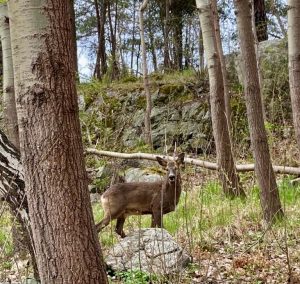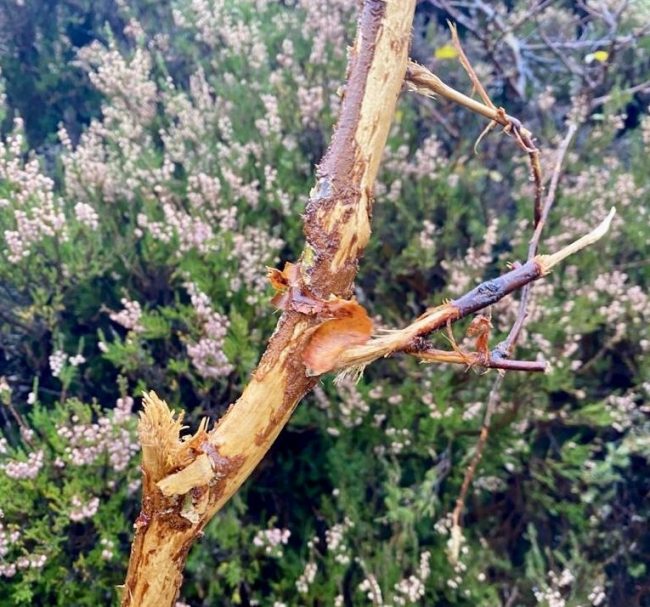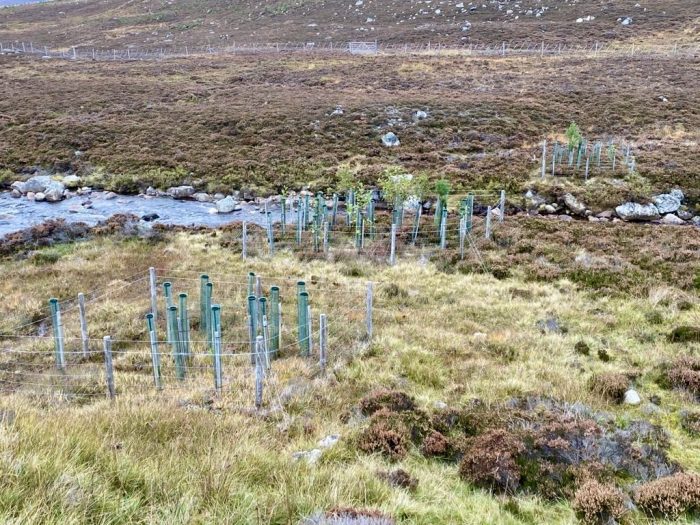Deer in woodlands

Woodland covers some 1,000 hectares of the Ashdown Forest, that is roughly 40% of its area. Much of the woodland is relatively young. However, the forest’s capacity for regeneration / renewal is being damaged by overgrazing. Local deer populations have grown and now represent a problem. Deer browse / graze on vegetation, shoots, flower buds and foliage are stripped off plants. Young saplings are damaged and bark is eaten, especially when food is scarce. Consequently, tree and shrub regeneration is limited. Other species are affected by the feeding of the deer, either through loss of niches or food. Among those at risk are small mammals and certain butterfly species.

deer damage
Damage is found in woodlands in many parts of the country, as deer populations have increased in recent times. In the 1970s, the deer population was estimated to be around 450,000 as compared to today’s estimates of over 2 million. The National Forest Inventory highlighted that "40 percent of British forests have ‘unfavourable’ levels herbivore damage, which limits the survival of young trees and threatens biodiversity". Apart from deer damage, there is damage by the grey squirrel populations.
Deer browsing can :
- Prevent natural regeneration
- Affect biodiversity
- Affect woodland resilience
- Reduce food availability to the herd which can lead to starvation / loss of condition
Deer are also hosts to ticks. The ticks may be infected with Borrelia burgdorferi bacteria and transmit them to humans, resulting in Lyme disease. Deer also contribute to collisions with motor vehicles; more than 450 deer were hit by vehicles on Hampshire roads last year . In Scotland, government agency figures indicate that deer vehicle collisions [DVCs] have almost doubled between 2008 and 2020. Sadly, people are injured or killed in DVCs, and the repair cost to vehicles runs into millions.
The solution to the ‘problem’ is not clear cut. Culling [the selective killing of animals] to control deer populations is one way in which numbers can be reduced, and the damage to woodland mitigated. However, this approach has been met with opposition by many, including animal rights organisations. There is the argument that whilst a reduction in deer numbers might fix some problems in the short term, the subsequent increase in plant growth and food availability might lead to increased breeding by the remaining deer and numbers would then increase again. Also, unsuccessful or inaccurate shooting leads to animal suffering, mutilation and / or a lingering death. Some might advocate rewilding and the introduction of apex predators (such as the wolf, lynx, wild cats*) as a means of reducing numbers but that might raise other problems!
Deer have been 'part and parcel' of woodlands since mediaeval times, when the forests were used for hunting. In the Ashdown Forest, the number of red deer declined during the C17th, and poaching was a factor in their decline. Fallow deer numbers also declined. [Fallow deer were introduced to England by the Normans around 1100 AD.] The deer population roaming the forest has increased significantly in the recent decades, and now there are the relatively recently introduced species, muntjac and sika deer. There are six species of deer in UK woodlands – the two native species, the red deer and roe deer and fallow, muntjac, sika and chinese water deer make up the four non-native species.
The problem of over grazing is not unique to the Ashdown forest. For example, deer numbers in Scotland have doubled in recent years to almost a million since 1990. Finding sustainable (and humane) solutions to the large numbers of deer is difficult.
* Wildcats were once widespread in Britain, but by the end of the 18th century, they were to be found only in the northern regions.

Remnants of birch woodland near Loch Muick are subject to browsing by red deer (especially in the winter), so temporary fences have been put in place to allow for regeneration.
Comments are closed for this post.
Discussion
Deer stalking with a management plan is the correct method of control. Deer stalkers in the U.K. take pride in ensuring they are ethical and humane when completing management of this ever increasing population to limit the impact on flora and fauna alike.
The only solution seems to be systematic and sustained humane culling.

I think this is a major problem not tackled at all by any government. We need a National Plan. This will be focused as regional methodology.
It will involve a National Eat Venison Promotion. This should be cheap, widely available and promoted as a very healthy ” eco” food source.
Selective areas vould have a re-introduction of European Lynx. These are shy, nocturnal, specialist deer predators….
Some farmers will whinge (whats new… ), there should be a well run compensation scheme..for the small loss of lambs…..shepherd dogs will make a major difference.
Finally Scientists should work on deer contraception…it just needs incentive priming…we can contracept most mammal, we just need a funded scheme.
Unless all this is implemented we are wasting our time generating lots of well meaning charity money / tax breaks / National Forest Schemes.
We need at least 50% fewer deer. In the case of Reeves Muntjac…we need a National Bounty Scheme..similar to that which eradicated Coypu from the Norfolk Broads.
Carl Stuttard
29 June, 2024